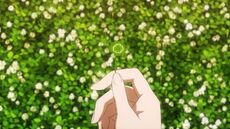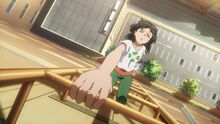
|
Index-tan: "Sogebu! Sogebu! Sogebu!" This article discusses intricacies or terms found in the fandom, it may not be found in the Toaru Majutsu no Index canon. |

The theme of clovers in Toaru Kagaku no Railgun S is one of the more obvious properties of Cloverfield.
Cloverfield (
Terminology
The term cloverfield is most likely derived of the abundance of clovers in the Toaru Kagaku no Railgun S as a theme. The term "Nagai Space" comes from Nagai Tasuyuki's family name. The first appearance of clovers occur in episode 7 of the anime right in the middle of the Sisters Arc, where most of the plot focuses on not Misaka Mikoto but on Shirai Kuroko and her attempts to find a four leaf clover as a good luck charm in Academy City.
Principles

Ruiko conveniently saves Erii.
Tatsuyuki Nagai is an anime director mostly known for his work on drama such as Toradora and Ano Hi Mita Hana no Namae o Boku-tachi wa Mada Shiranai, and has notably directed Honey and Clover II, a series with clovers as a main theme. His style shows prominently in the Railgun anime. In Toaru Kagaku no Railgun though some dramatic scenes are present in the original manga, the anime adaptation has them moved around, allowing for an episode focusing entirely on character drama instead of the story, making for the anime having a much more subdued pace. An example of this is episode 2 of Toaru Kagaku no Railgun, whose content was taken from chapter 17 of the original manga.
Other reasons are as follows:
- The cluttering of the Toaru Majutsu no Index timeline through original episodes with multiple days passing each episode. This extends to the Toaru Kagaku no Railgun (PSP game).
- The flanderization of character personalities like Shirai Kuroko, Misaka Mikoto, and Kongou Mitsuko.
- The usage and rearrangement of material from the manga that does not fit with how it was originally presented in the manga.
- The repetitive use of gags and establishing scenes. An example of this is Kuroko molesting Mikoto and characters eating things.
- Excessive focus on characters irrelevant to the manga plot, such as Haruue Erii and Edasaki Banri.
- The weakening and giving characters "plot-induced stupidity" in order for other characters to come to another's aid.
- Perceived favoritism towards certain characters appearing in scenes (most often cited to be Saten Ruiko).
Spread
The term, in Japanese, appeared on Japanese blogs as early as September 7 of 2013, an entire day after the airing of episode 21 of Toaru Kagaku no Railgun S, the very episode where Mikoto asks for her friends for help. The term later jumped into the Western fandom on September 10 after it was translated on 4chan's anime board. On September 14, the Index atwiki published an article regarding the term.[1]
Trivia
- Perhaps the term being a further reference to it, Nagai also directed Honey and Clover II,
External Links
- Cloverfield from the Index Atwiki
